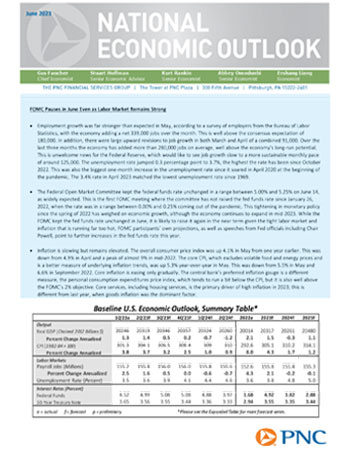La información contenida en este sitio es a saber y entender de PNC Bank, correcta y precisa, pero PNC Bank no declara, manifiesta ni garantiza su exactitud. Cualquier descarga de material contenido en este sitio o de cualquier sitio vinculado a este sitio puede ser una violación de las leyes federales de marcas comerciales y derechos de autor.
Perspectiva económica nacional de PNC
Enero de 2024
El crecimiento del PIB se mantiene fuerte en el cuarto trimestre, mientras el mercado laboral sigue resistiendo
El PIB real aumentó un fuerte 3.3 % a una tasa anualizada en el cuarto trimestre de 2023, según la estimación anticipada de la Oficina de Análisis Económico. (La publicación fue posterior a la elaboración del pronóstico de enero). El crecimiento fue del 4.9 % en el tercer trimestre. El crecimiento para todo el año 2023 en términos intertrimestrales fue un 3.1 %, mejor que el 0.7 % de 2022, y aproximadamente el doble del potencial a largo plazo de la economía. El crecimiento fue generalizado en el cuarto trimestre, en el que todos los componentes principales contribuyeron al crecimiento. El gasto real del consumidor aumentó un 2.8 % en el trimestre, lo que suma 1.9 puntos porcentuales al crecimiento anualizado. La inversión fija de las empresas aumentó un 1.9 %, lo que suma 0.3 puntos porcentuales al crecimiento. La inversión en vivienda aumentó un 1.1 %, aunque su contribución al crecimiento fue mínima. Con la caída de las tasas hipotecarias a fines de 2023, la inversión en vivienda ha aumentado en dos trimestres consecutivos, tras nueve trimestres seguidos de descenso. La reducción del déficit comercial sumó 0.4 puntos porcentuales al crecimiento en el cuarto trimestre, ya que las exportaciones aumentaron más que las importaciones (un 6 % y un 2 %, respectivamente). El aumento del gasto público sumó 0.6 puntos porcentuales al crecimiento del cuarto trimestre. Los bienes de cambio fueron un factor positivo modesto para el crecimiento del cuarto trimestre.
El reporte de empleo de diciembre de 2023 resultó mejor de lo esperado. El empleo, medido en una encuesta a empresas, aumentó en 216,000 puestos de trabajo durante el mes, por encima de las expectativas del consenso de alrededor de 170,000 puestos. Sin embargo, se produjeron importantes ajustes a la baja del crecimiento del empleo en octubre y noviembre, que sumaron 71,000 puestos. El sector privado sumó 164,000 puestos de trabajo en diciembre, mientras que el empleo público aumentó en 52,000 puestos. Durante todo el 2023, la economía estadounidense sumó un promedio de 225,000 puestos de trabajo al mes, por debajo del promedio de 399,000 de 2022.
La tasa de desempleo se mantuvo estable en el 3.7 % en diciembre, con una contracción tanto del empleo como de la población activa. La tasa de desempleo se ha mantenido por debajo del 4 % durante casi dos años, lo que representa la racha más larga de este tipo desde finales de la década de 1960. El empleo en una encuesta de hogares (diferente de la encuesta de empleadores) cayó en 683,000 en diciembre, tras un aumento de 586,000 en noviembre; el empleo es mucho más volátil en la encuesta de hogares. En los tres meses transcurridos hasta diciembre, la pérdida promedio de empleo en la encuesta de hogares fue de 122,000 puestos de trabajo. El número de personas en la población activa (que trabajan o buscan trabajo en la encuesta de hogares) disminuyó en 676,000 en diciembre. La tasa de participación en la fuerza laboral (la proporción de adultos que forman parte de la fuerza laboral) bajó del 62.8 % registrado en noviembre al 62.5 % en diciembre. Es la tasa de participación en la fuerza laboral más baja desde febrero. Si se mantiene, la caída de la tasa de participación en la fuerza laboral podría provocar un mayor endurecimiento del mercado laboral.


